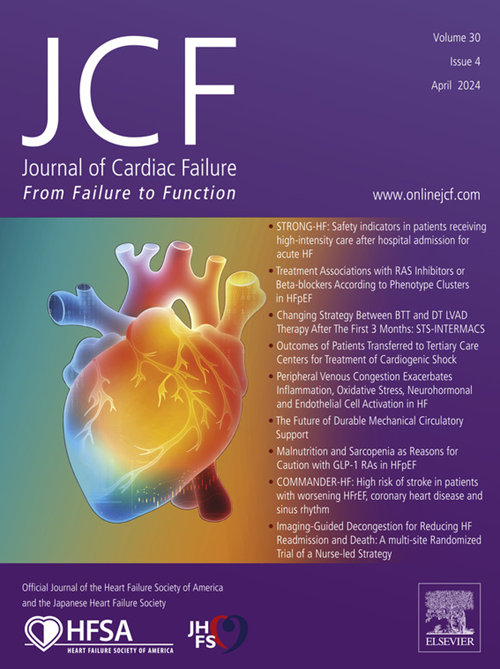GLP-1 Receptor Agonist in Nonobese Patients with Type 2 Diabetes Mellitus and Heart Failure with Preserved Ejection Fraction
IF 6.7
2区 医学
Q1 CARDIAC & CARDIOVASCULAR SYSTEMS
引用次数: 0
Abstract
Background
Glucagon-like peptide-1 receptor agonists (GLP-1RAs) promote weight loss and improve heart failure-related symptoms, quality of life, and functional capacity in patients with obesity and heart failure with preserved ejection fraction (HFpEF). However, their clinical effectiveness in nonobese patients with diabetes and HFpEF is understudied.
Methods
The TriNetX research network was used to identify adult patients (≥18 years) with type 2 diabetes mellitus (T2DM), heart failure with preserved ejection fraction (left ventricular ejection fraction ≥45%), elevated brain natriuretic peptide (≥ 150 pg/mL) or N-terminal pro-B-type natriuretic peptide(≥ 450 pg/mL) and a body mass index (BMI) <30 kg/m2 on or before August 31, 2022. Patients were divided into two groups based on GLP-1RA use. After propensity score matching, Cox proportional hazard ratios (HRs) were used to compare outcomes over a 12-month follow-up period.
Results
The study included 84,990 patients (n= 42,495 per group, mean age 64 years, 49% females, 65% white). Patients on GLP-1RAs were associated with lower incidence of heart failure exacerbation events (HR 0.60, 95% CI 0.58-0.62, p<0.001) and all-cause emergency room visits or hospitalizations (HR, 0.67, 95% CI 0.66–0.69; P < .001) compared with those not on GLP-1RAs. Other outcomes, including acute myocardial infarction, atrial fibrillation, ischemic stroke, pulmonary hypertension, C-reactive protein ≥ 5 mg/L, acute kidney injury, and the need for renal replacement therapy, were also significantly less frequent in the GLP-1RA group. These associated benefits persisted even among patients on a sodium-glucose cotransporter-2 inhibitor (SGLT2i).
Conclusion
GLP-1RA use is associated with improved cardiovascular outcomes in nonobese patients with T2DM and HFpEF and has an associated incremental benefit even among patients on SGLT2i.
GLP-1 受体激动剂在非肥胖 2 型糖尿病合并射血分数保留型心力衰竭患者中的应用
背景:胰高血糖素样肽-1受体激动剂(GLP-1RA)可促进肥胖和心力衰竭保留射血分数(HFpEF)患者的体重减轻,改善心力衰竭相关症状、生活质量和功能能力。然而,它们在非肥胖糖尿病和HFpEF患者中的临床效果尚未得到充分研究。方法:TriNetX研究网络用于识别2型糖尿病(T2DM)、心力衰竭并保留射血分数(左心室射血分数≥45%)、脑钠肽(≥150pg/mL)或n -末端前b型钠肽(≥450pg/mL)和体重指数(BMI)的成年患者(≥18岁)。结果:研究纳入84,990例患者(每组n= 42,495例,平均年龄64岁,49%女性,65%白人)。使用GLP-1RA的患者心衰加重事件发生率较低(HR 0.60, 95% CI 0.58-0.62)。结论:使用GLP-1RA与非肥胖T2DM合并HFpEF患者心血管结局改善相关,即使在SGLT2i患者中也有相关的增量获益。
本文章由计算机程序翻译,如有差异,请以英文原文为准。
求助全文
约1分钟内获得全文
求助全文
来源期刊

Journal of Cardiac Failure
医学-心血管系统
CiteScore
7.80
自引率
8.30%
发文量
653
审稿时长
21 days
期刊介绍:
Journal of Cardiac Failure publishes original, peer-reviewed communications of scientific excellence and review articles on clinical research, basic human studies, animal studies, and bench research with potential clinical applications to heart failure - pathogenesis, etiology, epidemiology, pathophysiological mechanisms, assessment, prevention, and treatment.
 求助内容:
求助内容: 应助结果提醒方式:
应助结果提醒方式:


